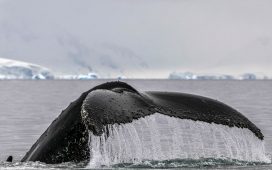Some sixty-six million years ago, a scene of unimaginable horror played out in a North Dakota floodplain now aptly known as the Hell Creek Formation.
It came without warning; Earth shook violently with the seismic waves originating from an impact equal to a magnitude 10 or 11 earthquake, and deadly glass beads rained down from the sky like tiny ballistic missiles traveling 200 miles per hour.
But for Cretaceous life in Hell Creek, it would be the waves that proved most devastating.
Through six years of digs at the site, a paleontologist has finally confirmed something he’s long suspected – in the heart of North Dakota lies a prehistoric ‘killing field’ that may be the best evidence yet of the events that occurred during Earth’s most notorious mass extinction.
Fossilized fish, vegetation, mammals, insects, marine reptiles, and even part of a Triceratops lay piled atop one another, preserving for eternity the moment a 30-foot wall of water pummeled the landscape and buried all living creatures in its path.
According to paleontologist Robert DePalma, it’s the first ‘mass death assemblage’ of large lifeforms that’s ever been found from the dinosaur extinction event.

Fossilized fish, mammals, insects, marine reptiles, and part of a Triceratops lay piled atop one another, preserving for eternity the moment a 30-foot wall of water pummeled the landscape and buried all living creatures in its path. An artist’s impression of the scene is shown
It’s not just another cache of Cretaceous fossils – the scene discovered at what’s now known as the Tanis outcrop may well be the Holy Grail.
‘At no other K-T boundary section [end of the Cretaceous Period] on Earth can you find such a collection consisting of a large number of species representing different ages of organisms and different stages of life, all of which died at the same time, on the same day,’ a said DePalma, curator of paleontology at the Palm Beach Museum of Natural History in Florida and a doctoral student at the University of Kansas.
During the Cretaceous, the Hell Creek Formation was home to an inland sea that hosted all sorts of prehistoric life, from mosasaurs to snail-like cephalopods called ammonites.
When the asteroid struck thousands of miles way, it birthed a tsunami-like wave that temporarily reversed the flow of a nearby river and tossed hundreds, even thousands of sturgeon and paddlefish onto land.
There, stranded on the sand bar, the fish were then pelted by high-speed glass beads called tektites that rained down from the sky as a product of rock melted during the impact.
Paddlefish were found to have tektites embedded in their gills, which likely occurred as they swam through the water, mouth agape, raking in food. Experts say they were ‘the first direct victims of the impact.’
All of this can be seen in the fossilized deathbed at the Hell Creek Formation.
‘It’s like a museum of the end of the Cretaceous in a layer a meter-and-a-half thick,’ said Mark Richards, a professor of earth and space sciences at the University of Washington.

When the asteroid struck thousands of miles way, it birthed a tsunami-like wave that temporarily reversed the flow of a nearby river and tossed hundreds or thousands of sturgeon and paddlefish onto land. A fish tail from Tanis deposit can be seen above

Stranded on the sand bar, fish were pelted by high-speed glass beads called tektites (pictured) that rained down from the sky as a product of rock melted during the impact
DePalma and colleagues, including researchers from the University of California, Berkeley and Vrije Universiteit in Amsterdam, have detailed their remarkable findings in paper set to be published next week in the journal Proceedings of the National Academy of Sciences.
The fossil record shows glass beads continued to rain down on the surface for 10 to 20 minutes after the first wave, before a second hit and buried the stranded fish in sand and gravel.
‘The seismic waves start arising within nine to 10 minutes of the impact, so they had a chance to get the water sloshing before all the spherules had fallen out of the sky,’ Richards said.
‘These spherules coming in cratered the surface, making funnels – you can see the deformed layers in what used to be soft mud – and then rubble covered the spherules. No one has seen these funnels before.’

‘Tsunamis from the Chicxulub impact are certainly well-documented, but no one knew how far something like that would go into an inland sea,’ DePalma said. The team determined there were at least two massive waves, which battered the land with about 20 minutes in between
DePalma has been digging at Hell Creek since 2013. And in the years since, his team has identified fish, burned tree trunks, conifer branches, dead mammals, mosasaur bones, insects, the partial carcass of a Triceratops, marine microorganisms called dinoflagellates, and ammonites in the Cretaceous graveyard.

Walter Alvarez and Robert DePalma are pictured at the Tanis outcrop in North Dakota
The researchers say seismic waves likely hit the area within 10 minutes of the impact, spurring a standing wave in the inland sea.
All the while, tektites fell at speeds of 100 to 200 miles per hour.
‘You can imagine standing there being pelted by these glass spherules,’ Richards said.
‘They could have killed you.’
The team suspects there were at least two massive waves, called seiches, which battered the land with only about 20 minutes in between, ultimately dropping more than six feet of deposits on top of the doomed creatures at the site.
This thick deposit is sealed off with a layer of iridium-rich clay – a material that’s rare on Earth, but common in asteroids and comets.
‘Tsunamis from the Chicxulub impact are certainly well-documented, but no one knew how far something like that would go into an inland sea,’ DePalma said.

The team has identified fish, burned tree trunks, conifer branches, dead mammals, mosasaur bones, insects, a Triceratops, marine microorganisms called dinoflagellates, and ammonites in the Cretaceous graveyard. Fish carcasses and two logs tossed together are shown above
‘When Mark came aboard, he discovered a remarkable artifact — that the incoming seismic waves from the impact site would have arrived at just about the same time as the atmospheric travel time of the ejecta,’ DePalma said.
‘That was our big breakthrough.’
The stunning discovery now represents a direct glimpse into what’s known as the K-T boundary – or, the end of the Cretaceous Period and the beginning of the Tertiary Period.
Bodies piled atop one another at Hell Creek and preserved in fossil form are just a snippet of the widespread devastation that resulted from the Chicxulub impact; when the asteroid struck, it ultimately wiped out 75 percent of life on Earth.














